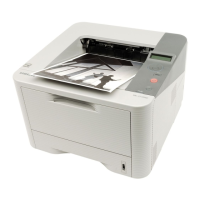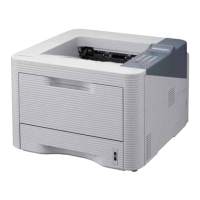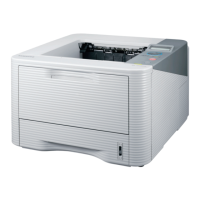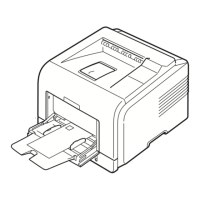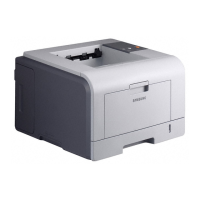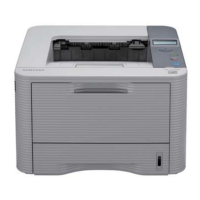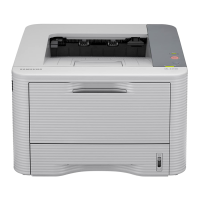
Do you have a question about the Samsung ML-3712ND and is the answer not in the manual?
| Wi-Fi | No |
|---|---|
| Network ready | Yes |
| Print technology | Laser |
| Maximum resolution | 1200 x 1200 DPI |
| Time to first page (black, normal) | 6.5 s |
| Print speed (black, normal quality, A4/US Letter) | 35 ppm |
| Printing colors | Black |
| Maximum duty cycle | 80000 pages per month |
| Number of print cartridges | 1 |
| Page description languages | Epson ESC/P2, Epson FX, IBM ProPrinter, PCL 5e, PCL 6, PostScript 3 |
| Processor model | Samsung |
| Maximum internal memory | 384 MB |
| Sound power level (standby) | 26 dB |
| Sound pressure level (printing) | 52 dB |
| Display | LCD |
| Total input capacity | 250 sheets |
| Total output capacity | 151 sheets |
| Maximum input capacity | 770 sheets |
| Total number of input trays | 2 |
| Multi-Purpose tray input capacity | 50 sheets |
| Maximum print size | 216 x 356 mm |
| Paper tray media types | Bond paper, Card stock, Envelopes, Labels, Plain paper, Pre-Printed, Recycled paper, Transparencies |
| Non-ISO print media sizes | Letter |
| ISO A-series sizes (A0...A9) | A4 |
| Standard interfaces | Ethernet, USB 2.0 |
| Optional connectivity | Parallel |
| USB 2.0 ports quantity | USB 2.0 ports have a data transmission speed of 480 Mbps, and are backwards compatible with USB 1.1 ports. You can connect all kinds of peripheral devices to them. |
| Mac operating systems supported | Mac OS X 10.3 Panther, Mac OS X 10.4 Tiger, Mac OS X 10.5 Leopard, Mac OS X 10.6 Snow Leopard |
| Other operating systems supported | IBM iSeries |
| Server operating systems supported | Windows 2000 Server, Windows Server 2003, Windows Server 2008 |
| Power consumption (off) | 3.5 W |
| Power consumption (printing) | 550 W |
| Power consumption (PowerSave) | 60 W |
| Compatible operating systems | Windows 2000 / XP(32 / 64 bits) / Vista (32 / 64 bits) / 2003 Server (32 / 64 bits) / 2008 Server (32 / 64 bits) / 7 (32 / 64 bits) / 2008 Server R2 (64 bits) Various Linux OS: RedHat Enterprise Linux WS 4, 5 (32 / 64 bit) Fedora 4, 5, 6, 7, 8, 9, 10, 11, 12 (32 / 64 bit) SuSE Linux 10.0, 10.1 (32 bit) OpenSuSE 10.2, 10.3, 11.0, 11.1, 11.2 (32 / 64 bit) Mandriva 2005, 2006, 2007, 2008, 2009, 2009.1 (32 / 64 bit) Ubuntu 5.04, 5.10, 6.06, 6.10, 7.04, 7.10, 8.04, 8.10, 9.04, 9.10 (32 / 64 bit) SuSE Linux Enterprise Desktop 10, 11 (32 / 64 bit) Debian 4.0, 5.0 (32 / 64 bit) Mac OS 10.3 ~ 10.6 UNIX OS: Sun Solaris 9, 10 (x86, SPARC) HP-UX 11.0, 11i v1, 11i v2, 11i v3 (PA-RISC, Itanium) IBM AIX 5.1, 5.2, 5.3, 5.4 |
| Dimensions (WxDxH) | 366 x 358 x 252.9 mm |
|---|
Features and advantages of the product, including eco-friendly aspects, print quality, speed, and connectivity.
Comparison of features and options available across different product models.
Useful tips and answers to common questions for product operation.
Information about the manual's structure, notation, and conventions.
Crucial safety instructions and precautions for product usage and handling.
Visual identification of product components and included accessories.
Explanation of buttons and indicators on the product's control panel.
Step-by-step guide for powering on the product.
Instructions for installing printer drivers locally via USB connection.
Steps to uninstall and reinstall printer drivers if issues arise.
Overview of the product's menu structure and available options for settings.
Procedure to print a test page to verify product functionality.
Guide to changing the display language on the product's control panel.
Information on selecting and using appropriate paper types and loading them into the paper trays.
Basic instructions and settings for printing documents.
Information on how to order consumables and optional parts.
Details on compatible consumables like toner cartridges and their specifications.
Information on optional components to enhance product performance or capacity.
List of replaceable maintenance parts and their expected lifespan.
Procedure to shake the toner cartridge to improve print quality temporarily.
Step-by-step instructions for replacing the toner cartridge.
Guide for installing additional memory modules to enhance product performance.
How to check the remaining life or status of consumables.
Configuring alerts for low toner levels.
Instructions for cleaning the product's exterior and interior parts.
Tips and best practices to prevent paper jams.
Detailed steps for clearing paper jams from various locations in the product.
Explaining the meaning of status indicator lights and LEDs on the product.
Interpreting error messages displayed on the product and troubleshooting them.
Technical specifications of the product, including dimensions, weight, power, and environmental data.
Compliance information, safety declarations, and regulatory approvals for the product.
Copyright information and legal notices related to the manual.
Information on warranty, service policies, and how to obtain support.
Details about environmental certifications and eco-friendly aspects of the product.
Information regarding quality marks for after-sales service.
Guidelines for the proper disposal and recycling of the product and its consumables.
Information on electromagnetic compatibility and warnings against counterfeiting.
Step-by-step guide for installing software and drivers on Macintosh systems.
Instructions for uninstalling and reinstalling software on Macintosh.
Guide for installing software and drivers on Linux systems.
Steps to uninstall and reinstall software on Linux.
Introduction to network utility programs for managing network devices.
Instructions for connecting and configuring the product for wired network use.
Guide for installing printer drivers over a wired network connection.
Steps for configuring IPv6 network settings on the product.
Comprehensive guide to connecting and using the product wirelessly.
Accessing and printing information about product settings, consumables, and reports.
Configuring page layout options such as paper orientation and margins.
Settings related to paper handling, tray selection, and paper size/type.
Adjusting print quality settings like resolution and toner density.
Configuring system-level settings like date, time, power management, and auto-duplex.
Setting up printer emulation modes for compatibility with different languages.
Configuring network settings, protocols, and security options.
Managing administrative settings, user access, and security features.
Adjusting settings based on altitude to optimize print quality.
Changing font settings for different languages and character sets.
Customizing default print settings for various printing scenarios.
Designating the product as the default printer in the operating system.
Utilizing advanced printing features like N-up printing, poster printing, and duplex printing.
Using a utility to print files directly without opening an application.
Understanding and using features related to memory and hard disk storage.
Instructions for printing from Macintosh operating systems.
Guide for printing from Linux operating systems.
Instructions for printing from Unix operating systems.
